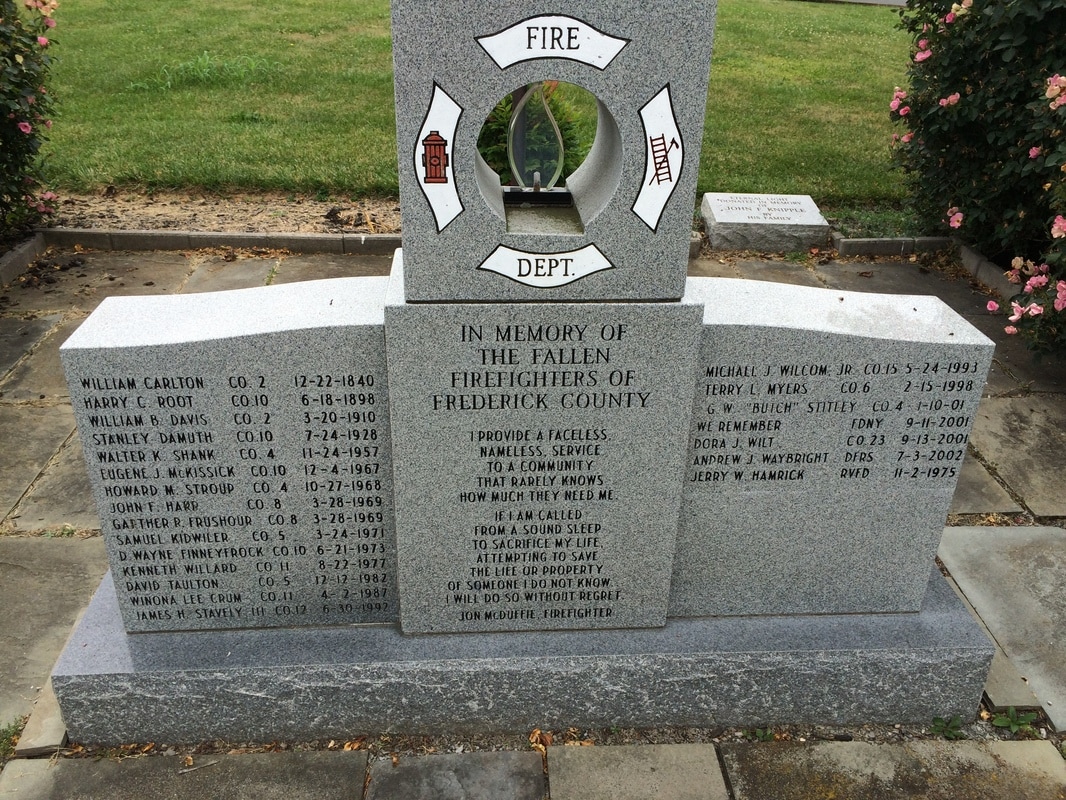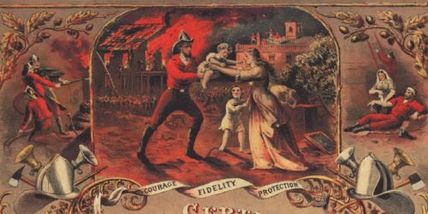 "Firemen are going to get killed. When they join the department they face that fact. When a man becomes a fireman his greatest act of bravery has been accomplished. What he does after that is all in the line of work. They were not thinking of getting killed when they went where death lurked. They went there to put the fire out, and got killed. Firefighters do not regard themselves as heroes because they do what the business requires." —Chief Edward F. Croker (1863-1951), FDNY In June 2000, a very special monument was erected in Mount Olivet Cemetery. It is located in front of the mausoleum complex to the rear of the historic burying ground. Known as the Fallen Firefighters Memorial of Frederick County, the polished collective of granite currently lists the names of 21 men and women who died in the line of duty. Two of the first three individuals listed on this monument served with the town’s second fire company, better known as the Junior Fire Company, No. 2.  The Junior Fire Company was organized in 1838, and incorporated in March of 1840 by an act of the General Assembly of Maryland. The “Juniors” trace their origin back to a chance meeting of three townspeople meeting at Dr. Alexander Mantz’s drugstore on the Square Corner (corner of Market and Patrick streets) and discussing the recent destruction of the home of Horatio Waters and others on S. Market Street by fire. These men came to the agreement that something needed to be done, and set about the movement to create another fire fighting entity in addition to the Independent Hose Company, officially organized in 1818 as the Frederick Hose Company. The three founders Dr. Alexander K. Mantz, George F. Webster and William Carlton issued the call for volunteers for a “Young Men’s Fire Company” through the town’s weekly newspaper entitled The Frederick-Town Herald. In the months that followed, local men answered the call to serve, and officers were elected. This was a company of younger, or junior, residents of town. Among these were William Pitts, President and William Carlton, Vice President.  Frederick-Town Herald, May 12, 1832) Frederick-Town Herald, May 12, 1832) Vice President William Carlton was well-connected in Frederick. His late father, Thomas Carlton (1783-1835), was a veteran of the War of 1812 had served two terms as Sheriff of Frederick County a decade later in the 1820’s. His public life continued with two terms as town mayor from 1829-1835. Mayor Carlton’s main claim to fame came in 1831 when he was influential in brokering the deal to have the Baltimore & Ohio Railroad come to town. This was the nation’s first railroad, and an argument can be made that Frederick-Town was the first major town the fabled transportation line would reach from its center of origin in Baltimore. Frederick resident and diarist extraordinaire Jacob Engelbrecht captured the historical moment with an entry dated Thursday, December 1, 1831, 5 PM: “Opening of the railroad—The Baltimore and Ohio Railroad was opened this day as far as Frederick City. Five cars came from Baltimore this day, in which came passengers, the president (Philip E. Thomas), and directors of the railroad, the Mayor & City Council (both branches), and the Governor of Maryland (George Howard Esquire) together with other officers of the company being upward of seventy in number. The citizens of Frederick gave them a dinner at Talbott’s hotel. The arrival of the cars was announced by the firing of cannon, ringing of the bells, & C, & C. It was a proud day for Frederick. The “car Frederick” was first. Mayor Thomas Carlton was responsible for the “Deep Cut” through All Saints Street which allowed the train to make its way to Market. Apparently, railroad tracks would eventually stretch up Frederick’s principal commercial street all the way to Fourth Street, as horse drawn train cars ran on tracks placed on wooden stringers. As a compliment to Mayor Carlton, a special car was sent to the front of Carlton’s home dwelling (located at the northwest corner of West Fourth and Market) on the occasion of his daughter Ann’s wedding to Lewis A. Brengle in 1834. Bride and groom were taken from here to the railroad depot (the present day site of the E. All Saints Parking Deck and Wm. Donald Schaefer Government Services building intersection of Carroll and Commerce streets).  Mayor Carlton’s son William Frederick Carlton was born September 13th, 1816 and grew up in Frederick. He and his colleagues with the new fire company venture contracted with the John Rodgers Company of Baltimore for an engine that cost $1,000. Local resident Henry Boteler provided hose reels, and hoses were gotten from another Baltimore firm named Dukehart’s. The engine, known as Rodger’s “Junior” model, made its debut in town in August, 1839. It was vermillion red in color, and was considered a “beauty.” It was immediately exhibited to the public with a show as it threw a stream of water 150 feet in the air over the town clock, located atop Trinity Church. The new apparatus was the centerpiece of the company that came to be known as the Juniors, and devoid of a fire house structure at the time, this was kept in a vacant lot in the rear of the original Farmers & Mechanics Bank location on the southwest corner of N. Market and 2nd streets. The year 1840 promised to be a great one for the 23-year old. He had accomplished the task of creating another fire company in town. He also had a fulfilling regular job as City Register, which we today generally call the Register of Wills. This individual is responsible for appointing personal representatives to administer decedent’s estates and for overseeing the proper and timely administration of these proceedings. On Saturday June 27th, 1840, Jacob Engelbrecht wrote in his diary: Married on Thursday evening last 25th instant by Reverend John L. Pitts, Mr. William Carlton (Register of this City) to Miss Mary P. Neill, daughter of the late John W. Neill of Philadelphia.  The summer of 1840 must have been one of bliss for the newlywed couple. Fall came, and perhaps with it, talk of starting a family of his own? Whatever the case, the remembrance of family would certainly play heavy on his mind with end of year holidays. His father, Thomas Carlton, was resting in peace in the new Evangelical Lutheran burying ground, once located at the southeast corner of East Street and E. Church Street extended (also known as the Gas House Pike). Next to his father was buried older brother Edward Alexander Carlton (1806-1834). Perhaps William visited this cemetery on December 20th, 1840, the sixth anniversary of his brother’s death? Whatever the case, he likely never imagined that he would join these loved ones in just a matter of days. Two days before Christmas, Jacob Engelbrecht would again put pen to paper regarding a member of the Carlton family: Died last evening in the year of his age, Mr. William Carlton, Register of this city, son of the late Thomas Carlton. His death was very sudden. There was a cry of fire in town about 6 or half past 6 o'clock PM (Colonel John McPherson’s chimney) and was running with the engine (Juniors Company of which he was a member) and when they got to Brien’s Row, Court Street, he became exhausted, fell down, and in short time, thereafter expired. Wednesday, December 23, 1840 12 o’clock Midnight  Frederick County Courthouse fire of 1842 Frederick County Courthouse fire of 1842 William Carlton would be the first firefighter in the State of Maryland to die in the line of duty. His body was placed next to his father and brother in the new Lutheran Graveyard on the east side of town. He had only been married for six months, leaving wife Mary to celebrate Christmas as a widow. The Junior Fire Company would live on. Two years following the death of their co-founder, the “Juniors” would take part in extinguishing one of the worst fires in Frederick history. Ironically, this would take place in the vicinity of Court House Square within feet of where William Carlton took his last breath. A fire had broken out at the Record Street home of Dr. William Tyler on March 31st 1842. Strong winds blew burning embers through the air, causing additional fires to start in adjacent structures including the Court House itself, when the cupola ignited and soon became engulfed in flames. A fire engine house for Company No. 2 would be built by the City Council four years later in 1846. The location was donated by the Farmers & Mechanics National Bank next to the same lot where the company’s engine had already been stored. The structure fronted N. Market Street, and had another prominent neighbor to the south in the old Market House, which also housed the town offices. Today, Brewers Alley stands on the Market House site.
For those wanting to visit the grave of William Carlton to pay respects, there is a bit of a snafu. His gravesite, along with father Thomas, brother Edward and mother Mary is unmarked—at least in Area NN. Supposedly, the Carlton headstones were once here in the cemetery, but in a completely different area. They once adorned a lot in Area P owned by the son of Lewis A. Brengle and wife Ann (Carlton) Brengle. You may recall that Ann was William’s sister, the one who got the free train ride down Market Street on her wedding day. Ann had died in 1852 but was originally laid to rest in the German Reformed Cemetery of town (today’s site of Memorial Park on the corner of Bentz and W. Second streets). Lewis would pass in 1879, and buried next to Ann. However, both would be reinterred in 1881 and moved to Mount Olivet (Area P/Lot 125).
0 Comments
Leave a Reply. |
STORIES
|
Archives
July 2024
June 2024
May 2024
April 2024
March 2024
February 2024
January 2024
December 2023
November 2023
September 2023
August 2023
July 2023
June 2023
May 2023
April 2023
March 2023
February 2023
January 2023
December 2022
November 2022
October 2022
September 2022
August 2022
July 2022
June 2022
May 2022
April 2022
March 2022
February 2022
January 2022
December 2021
November 2021
October 2021
September 2021
August 2021
July 2021
June 2021
May 2021
April 2021
March 2021
February 2021
January 2021
December 2020
November 2020
October 2020
September 2020
August 2020
July 2020
June 2020
May 2020
April 2020
March 2020
February 2020
January 2020
December 2019
November 2019
October 2019
September 2019
August 2019
July 2019
June 2019
May 2019
April 2019
March 2019
February 2019
January 2019
December 2018
November 2018
October 2018
September 2018
August 2018
July 2018
June 2018
May 2018
April 2018
March 2018
February 2018
January 2018
December 2017
November 2017
October 2017
September 2017
August 2017
July 2017
June 2017
May 2017
April 2017
March 2017
February 2017
January 2017
December 2016
November 2016















 RSS Feed
RSS Feed